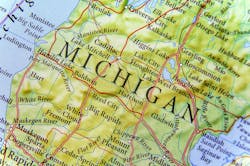One of the weak links in many state health information exchanges involves connections to Native American tribal organizations. In a recent interview, Krystal Schramm described efforts she is leading at Michigan Health Information Network Shared Services (MiHIN) to connect the 12 federally recognized tribes in Michigan in order to improve health outcomes and support a more equitable healthcare experience for the tribal communities.
To date, MiHIN has onboarded nine of the 12 federally recognized tribes and an Urban Indian Health Center. As MiHIN explains, because each of the 12 federally recognized tribes in Michigan is a sovereign nation, the tribal healthcare system faces piecemeal, disconnected and inconsistent data. That leads to poor care, delays and a lack of usable personal health records that can be shared among the various healthcare providers, clinics and even within families to ensure better outcomes.
A member of the Native community herself, Schramm, a senior technical business analyst, knew from personal experience that most tribal clinics were not connected. She says there is a lot trust-building that has to happen upfront before you get to the technical details of data exchange.
HCI: As you engage with the tribal organizations, do you get a sense that they recognize the value in getting more data on what's happening to tribal members when they're seen outside of their health systems, so that they get a more complete picture of their patients if they participate in the HIE?
Schramm: I have found that they absolutely see the value. They do referrals to other specialists outside of the tribal health system, and they're often on different EMRs and hospital data is really difficult to get. Even the one or two that have Epic still are missing valuable data from the hospitals and the specialists that they're outsourcing to. So they're definitely seeing the value now that they're getting some of that data.
HCI: And is the reverse also true? Are clinicians in hospitals, emergency departments and specialist groups gaining access to information about what's happening to those patients in the tribal system?
Schramm: Correct. With our Active Care Relationship Service, they'll be able to see ‘This is Krystal Schramm, and she goes to the Pokagon Clinic.’ I can say from personal experience, we've been in the hospital before and they're like, ‘What's Pokagon?’ They had no idea. So I think this will help educate those other facilities about where these patients are going. But I do think we've got a long way to go. We're really at the beginning stages. I think that the HIE with tribes is way behind regular HIE because we've been left out or it's been very minimal for so long.
HCI: Are some of the tribal organizations using the Indian Health Services’ health IT systems? Or is there a variety of EHR systems they use?
Schramm: It's a mix. What I found in my work is that about half of the tribes in Michigan are still on the Indian Health Service EMR system. There are some that have said we can't use that system because it is too old, it's holding us back, so they bought an off-the-shelf system and spent their own dollars to fund it, which also has its own set of challenges.
HCI: Where are you in the process of onboarding the tribes and getting to that next level of usage? Are some further along than others?
Schramm: There is one tribe we have recently been able to get onboarded to the Active Care Relationship Service. They're now receiving ADTs for their patients. And there are tribes up in the Upper Peninsula that have already been doing this for a while and they have been receiving those ADTs for their patients. I think that a next area of focus for those that are more advanced is getting labs back for their patients. They're starting to get some of that data now. On the other end of the spectrum, we still have tribes that are either only submitting immunizations or we're not engaged with at all, because either they're not ready for it or we're still making that connection. There is one tribe, the Saginaw Chippewa, we've been talking to for a long time and we're just starting to get the immunizations piece. That's the way to get them in the door. We've got another tribe, Little River, which actually is where I'm from, Little River, and we have not onboarded them to anything yet, so it's all over the spectrum. I'm trying to track them and continue to grow those relationships.
HCI: When you talk about the initial phase of building trust, what are some of the issues that have to be worked through?
Schramm: They don't want to be exploited. Data sovereignty is huge. They want to make sure that the data of their patients is protected. They want to make sure that we are a highly secure environment and that we have all of our certifications in place. And they want to make sure that we're not doing anything that's not going to benefit the tribes. Anytime any of their data has the potential to go somewhere where they can't control it, and research is one example. We work with the entire State of Michigan, and historically the tribes have not always had great relationships with the State of Michigan. So that's been a very delicate balance where I say ‘I'm tribal, I've got your back, but we do work with the State of Michigan, so you have to understand that too.’
HCI: Do you think the same issue exists around the country — that many tribal organizations aren't participating in state or regional HIEs?
Schramm: Yes, I do. I've actually had several agencies reach out to me from other states, and they've said, ‘How are you doing this? We want to learn from you.’ I said, ‘Well, being Native definitely helps.’ I have been able to establish that layer of trust, and I also really understand that population. I definitely think that there is a gap across the nation, with the exception of Alaska. Alaska is like 50 percent Native so they are very, very strong with this, but in the rest of the lower 49 I think there's definitely a gap.
Wisconsin is one of the states we work with. We've started having monthly conversations, because they've got tribes legally on-boarded, but then it stops, and nobody engages with them. They don't do that extra hand-hold. And what I found is that when you're onboarding tribes, you could do all the technical components the same way, but you need that extra touch, because you have to understand that they're not like everyone else, not like other healthcare systems.


